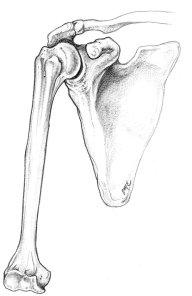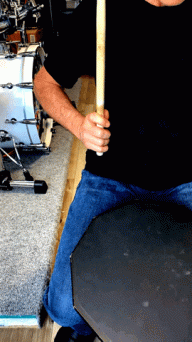Thank you for directly contradicting me! Geez...it's not that different than the german grip approach, the only change is the forearms are rotated slightly outwards upon beginning the stroke to create a greater range of motion...see my post to Matt Ritter. And you probably know there is no ulnar rotation in german grip, so changing the angle of the forearm upon starting doesn't mean I am rotating it during the stroke. The same goes with American grip, which you probably know is achieved by changing the angle of the forearm...rotating it outwards slowly from the german grip starting position. This doesn't mean that during American grip you are rotating the forearm for each stroke, it is still that same up and down pivoting from the elbow, as with german grip. And of course to just play with the palms down consistently like with german grip restricts the range of motion and doesn't work on the drumset at all, where the angles of your arms by necessity are constantly changing.
The outward rotation I'm seeing is more than 'slight', but ok
The rest of what you said, I don't have much disagreement with though slightly tangential topic. The grip change from german <-> american <-> french I agree is a forearm angle change. From drum movement flicks to grip changes, it's not static for sure.
I learned this stroke when I was 22. Now I am 59. I have played 1000's of gigs over the years and have had no physical problems. I believe I am a better drummer today than I have ever been. So my personal experience does not equate with your concerns.
I believe it, otherwise why share. But I still believe this could be interpreted pretty badly with a stiff grip into a hard pad on a 90 degree forearm rotation...eh
Sorry, but it's not true that this is a personal journey, because anatomically we are all the same.
No, my journey is not yours...and we are
definitely not all anatomically the same at all. In the basic sense, most of us have two arm with same fingers/thumbs....but there is so much variation within that.
You can't accept Moeller and reject this fundamental stroke. Because Moeller uses these exact same mechanics and then adds the whipping motion. The motion starts in the shoulder.
I'm not saying not to use shoulder or arm, of course we all use it...yes Moeller uses it for the whipping effect as you state. Moeller is fundamentally a gravity and centripetal concept while maintaining a hand fulcrum that extends into more advanced technique concepts like rebound and torque and finger techniques.
This fundamental stroke does none of this other than mimic the arm mechanic slightly to isolate it. But the whole arm motion from top to arm to finger of Moeller is the fundamental, not a sub-fundamental just isolate the start in the arm with a stiff grip to break the whole concept, so I can reject this very easily.
Would you tell an athlete not to use his shoulder/upper arm when throwing, shooting or hitting a ball? Of course not? It doesn't make sense!
Well, would you tell an athlete not use lower arm, wrist, hand and fingers when throwing a ball and just throw from their upper arm, of course not because that doesn't make sense! You really need the whole thing from top to bottom as it's a connected motion fundamentally, otherwise you start compensating for the lack of parts not introduced (like stressing the forearm protonation/supination mentioned, which does happen in sports activities).





